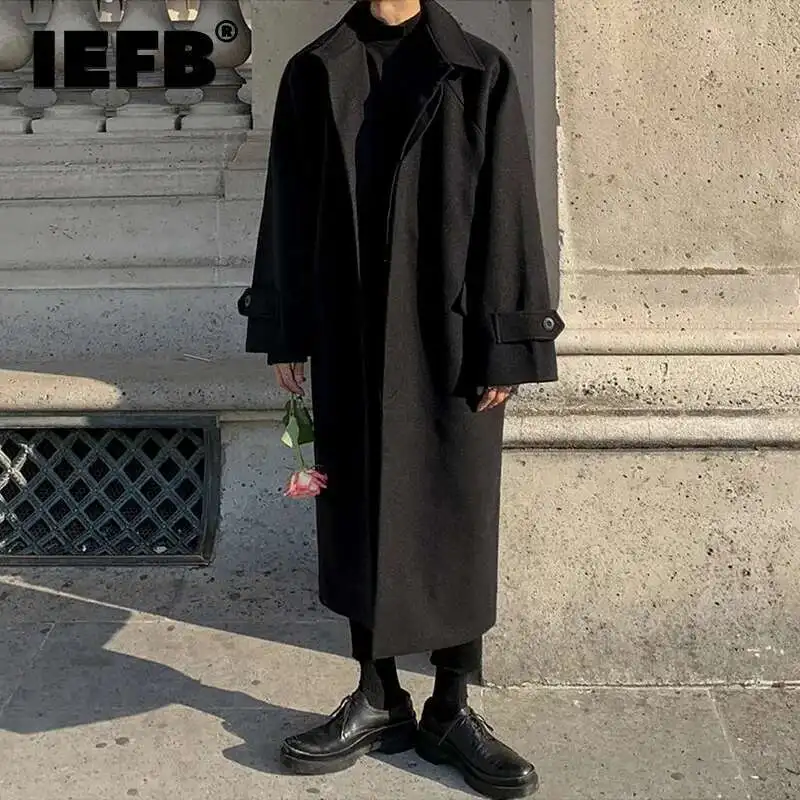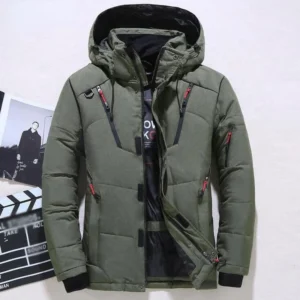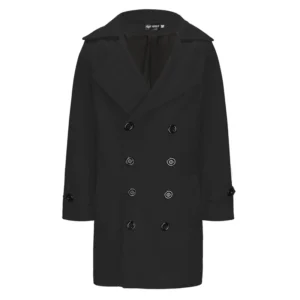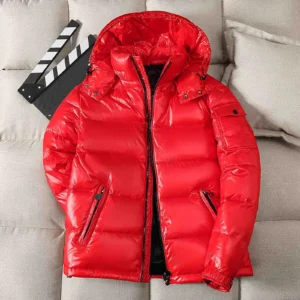Introduction: Understanding the Impact of Coat Length
The length of your coat is one of the most crucial yet overlooked aspects of men’s outerwear. It’s not merely a matter of style preference—coat length fundamentally affects your overall appearance, comfort level, and the garment’s functionality. When chosen correctly, the proper coat length can transform your entire silhouette, making you appear taller, more proportioned, and more polished.
Men who understand the importance of coat length gain an immediate advantage in their overall presentation. Even the most expensive coat made from premium materials will look awkward if it’s too long or too short for your frame. The right length creates visual harmony with your body proportions while providing appropriate coverage for your intended activities.
Understanding coat length fundamentals involves considering several key factors: your body type, typical occasions for wear, local climate, and personal style preferences. Each of these elements plays an important role in determining which coat length will serve you best.
Throughout this guide, we’ll explore how Metro Cloak approaches coat length in our premium designs, balancing timeless proportions with modern sensibilities. Our men’s overcoats collection showcases this attention to detail with various lengths crafted to enhance different body types and style preferences.
Understanding How Coat Length is Measured
Before diving into specific recommendations, it’s essential to understand how coat length is properly measured. This knowledge ensures you can accurately evaluate options whether shopping online or in person.
Standard coat length measurement starts at the center back of the collar (where it meets the shoulders) and runs vertically down to the bottom hem. This measurement provides the most consistent reference point across different coat styles.
When trying on a coat, keep these reference points in mind to evaluate proper length:
– Natural waist: Typically the narrowest part of your torso, often aligning with your belly button
– Hip bones: The widest part of your lower torso
– Mid-thigh: Approximately halfway between your hip and knee
– Knee: The joint where your leg bends
Different coat styles have different traditional lengths. For example, a peacoat typically ends at the hips, while a classic overcoat traditionally reaches to just above or below the knee. Understanding these conventions helps you determine if a particular coat follows traditional proportions or offers a more contemporary interpretation.
The relationship between proper measurement and perceived height is particularly important, as the wrong coat length can visually shorten your frame or create an imbalanced appearance.
The Complete Coat Length Spectrum: A Visual Guide
Let’s explore the full spectrum of coat lengths available in men’s fashion, from shortest to longest:
Cropped Coats (Above Waist)
These coats end above the natural waistline, typically resting at mid-torso. Common styles include bomber jackets, motorcycle jackets, and cropped peacoats. This length emphasizes the waist and legs while providing minimal coverage. Cropped coats create a casual, youthful appearance and work well for mild weather conditions.
Hip-Length/Waist-Length Coats (24-29 inches or 61-74 cm)
These coats end around the hip area, providing moderate coverage without extending down the legs. Popular hip-length styles include car coats, short peacoats, and casual jackets. This versatile length offers good mobility while providing more protection than cropped styles.
Mid-Thigh Length (30-33 inches or 76-84 cm)
Landing between the hips and knees, mid-thigh coats strike a balance between coverage and mobility. Common examples include field jackets, longer peacoats, and shorter trench coats. This length works particularly well for everyday wear and business-casual settings.
Knee-Length (34-38 inches or 86-97 cm)
Reaching to just above, at, or slightly below the knee, these coats provide substantial coverage while maintaining a classic proportion. Traditional overcoats, topcoats, and many trench coats fall into this category. This length is considered the most classic and versatile option for formal and business wear.
Midi/Calf-Length (39-45 inches or 99-114 cm)
Extending below the knee but above the ankle, these longer coats make a stronger style statement while providing additional coverage. Examples include longer trench coats, bridge coats, and some modern interpretations of overcoats. This dramatic length adds sophistication and warmth.
Maxi/Full/Ankle-Length (46+ inches or 117+ cm)
These coats reach to the ankles, providing maximum coverage and warmth. Traditional examples include full-length overcoats, greatcoats, and some formal dress coats. This length creates a bold, commanding presence and offers superior protection in severe weather.
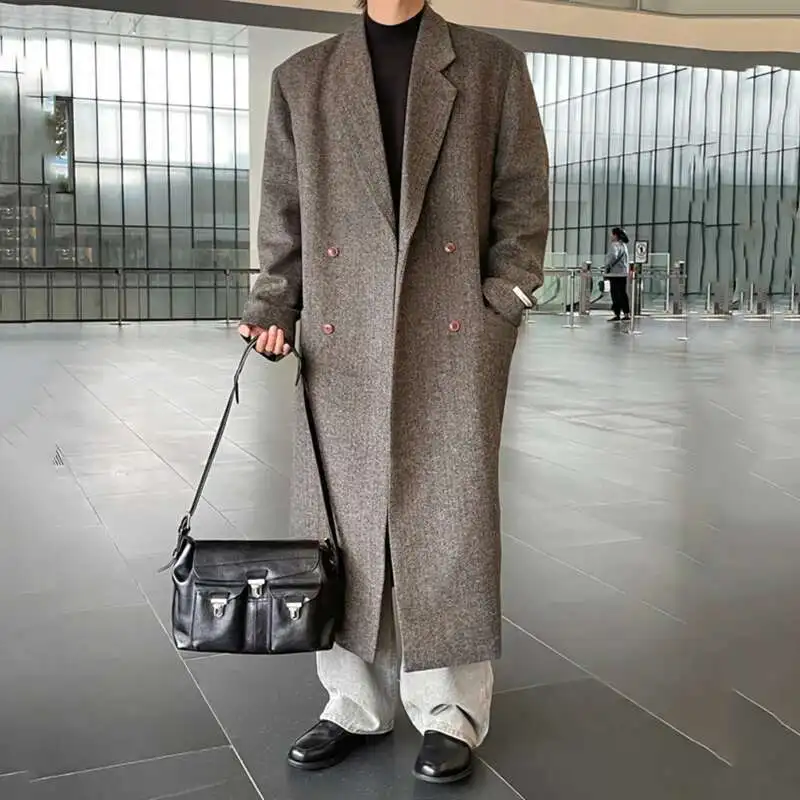
Each length creates a different visual effect on your silhouette and serves different functional purposes. Our long overcoat selection showcases various longer options that balance style with functionality, while our full coat length guide provides detailed information about maxi-length options.
Body Type and Height: Finding Your Most Flattering Coat Length
Your body’s proportions significantly influence which coat length will look best on you. The goal is to create visual balance that complements your natural build rather than working against it.
Height Considerations
Shorter Men (Under 5‘7” or 170 cm)
For men of shorter stature, coat length requires special attention to avoid overwhelming your frame. Generally, shorter men benefit from:
– Hip to mid-thigh length coats that don’t cut the body in half visually
– Avoiding extremely long coats that can make you appear shorter
– Slightly shorter sleeve lengths that create proper proportions
– Vertical design elements that elongate your silhouette
The perfect coat length for your height can make a significant difference in your overall appearance, particularly for shorter men who want to create a taller impression.
Average Height Men (5‘7”-5‘11” or 170-180 cm)
Men of average height enjoy the most versatility in coat length options:
– Mid-thigh to knee-length coats offer classic proportions
– Both shorter and longer styles can work depending on your preference
– Focus on the coat’s fit through the shoulders and chest for optimal appearance
Tall Men (Over 6’ or 183 cm)
Taller men can generally wear longer coat styles with ease:
– Knee-length to calf-length coats create balanced proportions
– Longer coats won’t overwhelm your height
– Pay attention to sleeve length to ensure adequate coverage
Body Shape Considerations
Athletic/Rectangle Build
Men with athletic or straight builds benefit from:
– Slightly fitted coats that add shape
– Mid-thigh to knee-length options that create balance
– Structured shoulders that enhance your natural V-shape
Broader Shoulders/V-Shape
For men with broader shoulders:
– Knee-length coats that balance your upper body
– Avoid excessively short styles that emphasize shoulder width
– Look for coats with clean lines that follow your natural tapered silhouette
Fuller Midsection
Men with a fuller midsection should consider:
– Single-breasted styles that create a cleaner line
– Mid-thigh to knee-length coats that provide coverage without adding bulk
– Slightly structured coats that create a more defined shape
The rule of thirds principle is helpful when determining proper coat length. This visual guideline suggests dividing your outfit into thirds vertically creates more pleasing proportions than splitting it in half. For example, if your coat comprises about 2/3 of your visible outfit with pants making up 1/3, you’ll often achieve a more balanced look than a 50/50 split.
Finding the perfect coat length for every body type involves balancing these principles with your personal comfort and style preferences. Men of shorter stature may find particular value in our guide to the best coat length for short men, which addresses specific proportion challenges.
Coat Length by Occasion: Matching Form to Function
Different situations call for different coat lengths, as both formality and functionality requirements change with context.
Business and Professional Settings
For business environments, coat length should project competence and professionalism:
– Knee-length overcoats are the traditional business standard
– Your coat should fully cover your suit jacket or blazer by 2-3 inches
– Mid-thigh to knee-length options work well for most professional contexts
– Consider a longer option for formal business settings in colder climates
The coat should allow comfortable movement during commuting while maintaining a polished appearance throughout the day.
Casual and Everyday Wear
For casual situations, prioritize comfort and practicality:
– Hip to mid-thigh lengths offer good mobility for active lifestyles
– Consider your typical activities—shorter coats work better for driving and active movement
– Weekend errands and informal gatherings usually favor shorter, more relaxed styles
– Layer-friendly lengths that work with casual clothing like jeans and sweaters
Formal Events
Special occasions often call for more traditional coat lengths:
– Knee-length to calf-length overcoats complement formal attire best
– Full-length options pair wonderfully with black tie and formal evening wear
– Consider the event venue and whether coat check will be available
– Longer coats create a more distinguished and elegant silhouette for significant events
Travel and Commuting
Your transportation methods should influence your coat length choice:
– Car drivers benefit from shorter coats that don’t bunch up when seated
– Public transit commuters may prefer longer coats for additional coverage while waiting outside
– Bicycle commuters typically need shorter styles for freedom of movement
– Frequent travelers should consider versatile lengths that work across multiple settings
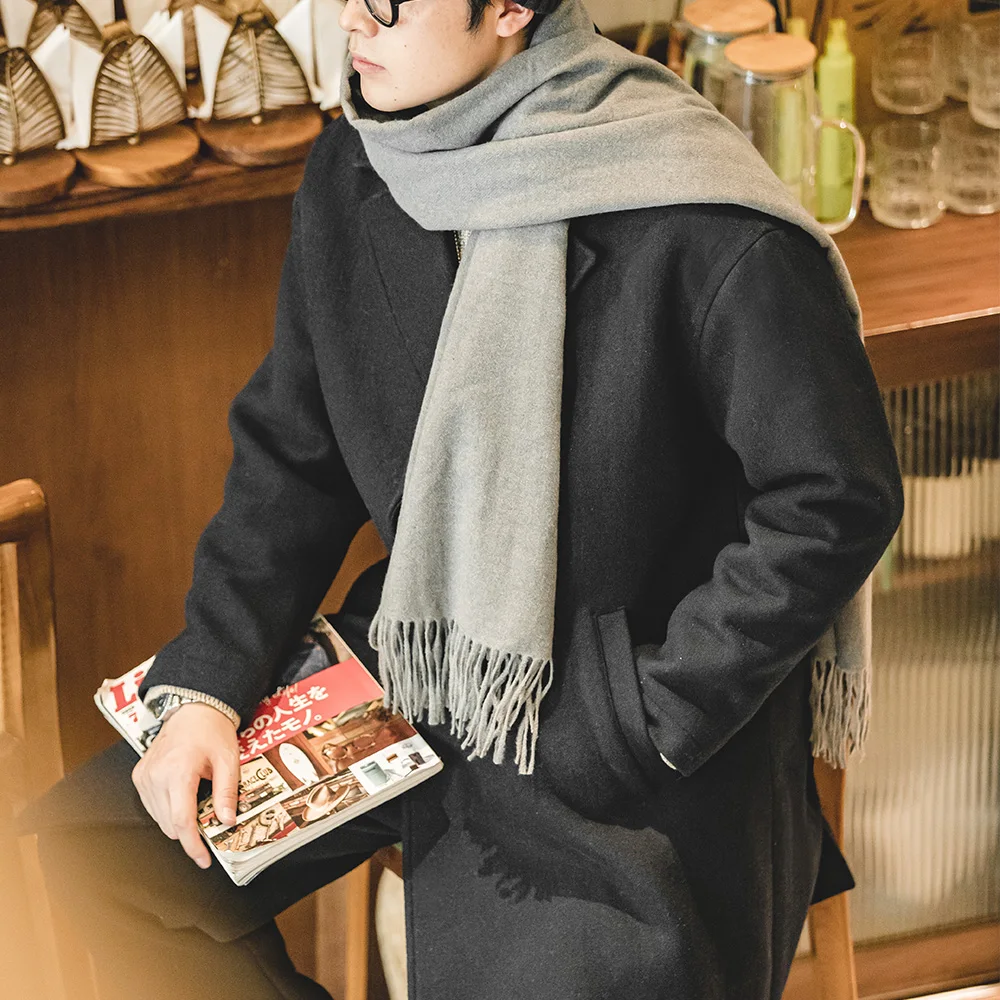
Our men’s dress coat collection features options with proportions appropriate for professional environments, while our guide to formal dress coats provides comprehensive information about length considerations for more structured garments.
Seasonal Considerations: Adapting Coat Length to Weather
Climate and seasonal factors play a crucial role in determining the most practical coat length for your needs.
Winter Coat Length
Winter typically calls for greater coverage:
– Knee-length to calf-length coats provide better protection against cold and wind
– Longer coats shield your legs when walking in cold conditions
– Consider snow levels in your region—higher snow might necessitate shorter coats
– Allow extra room for heavier layers underneath
Finding the perfect winter coat length involves balancing warmth requirements with your personal proportions and style preferences.
Fall/Spring Transitional Coat Lengths
Transitional seasons benefit from versatile mid-range lengths:
– Mid-thigh to knee-length options offer adaptable coverage
– Consider lighter materials that won’t overheat as temperatures fluctuate
– Designs with adjustable features like belts allow customization as conditions change
Cold Climate Considerations
In extremely cold regions:
– Calf-length to full-length coats provide maximum protection
– Consider functionality features like vents and adjustable closures
– Look for coats that cover most of your legs while still allowing comfortable movement
Mild Climate Adaptations
In milder regions:
– Hip to mid-thigh lengths usually provide adequate protection
– Focus more on style since extreme weather protection is less critical
– Consider unlined or lighter-weight options in longer lengths if you prefer that look
Our winter coat collection features various functional lengths designed to provide appropriate coverage and warmth for colder conditions.
Coat Style and Length: Natural Pairings
Certain coat styles have traditional length associations that balance aesthetics with functionality.
Classic Overcoat and Topcoat
Traditionally knee-length, these formal coats are designed to cover suit jackets completely. Modern variations may run slightly shorter (mid-thigh) for a more contemporary look while still providing appropriate coverage for business attire.
Trench Coat
The traditional trench coat falls to just below the knee, allowing rain to run off without soaking trouser legs. Contemporary versions range from mid-thigh (more casual) to calf-length (more dramatic and protective).
Peacoat
Originally designed for naval use, the classic peacoat ends at the hips or upper thigh. This shorter length enabled sailors to move freely while providing crucial warmth. Modern interpretations generally maintain this traditional proportion for authentic style.
Duffle Coat
This toggle-closed coat traditionally falls to mid-thigh or just above the knee. The moderate length balances warmth with mobility, making it practical for daily wear in colder conditions.
Parka and Technical Outerwear
Designed for severe weather protection, parkas typically range from mid-thigh to knee-length. The length is primarily functional, providing substantial coverage while allowing movement during outdoor activities.
Car Coat and City Coat
These practical coats usually end at mid-thigh—long enough to provide coverage while sitting in a car but not so long as to bunch up uncomfortably. This urban-friendly length balances protection with ease of movement.
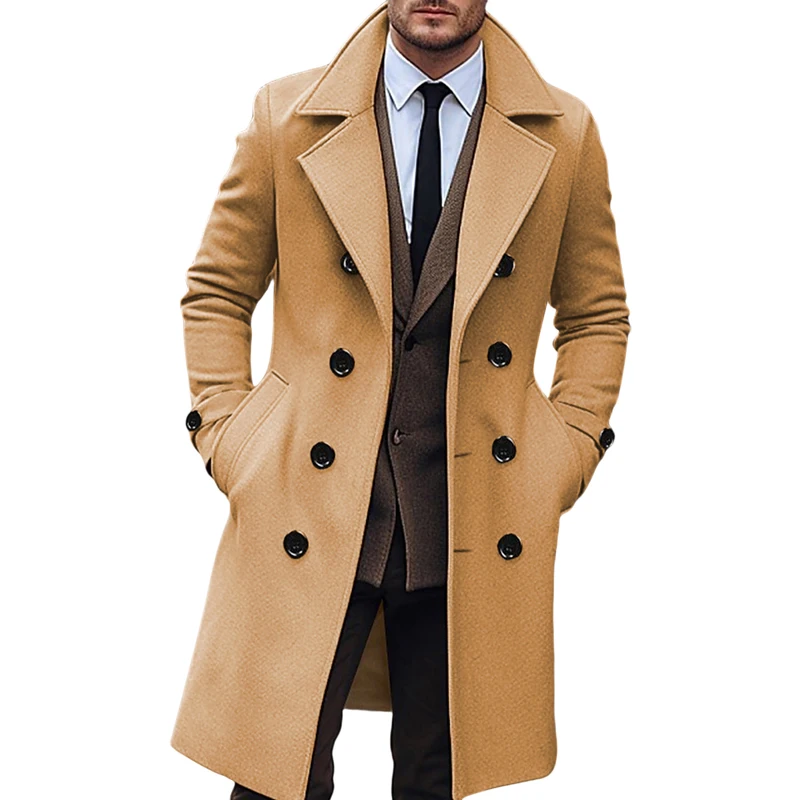
Our pea coat collection showcases the traditional shorter length of this classic style, while our car coat selection features the characteristic mid-length proportions ideal for urban environments. For those interested in more structured options, our double-breasted coats guide provides detailed information about appropriate lengths for this distinguished style.
How to Test Coat Length When Trying On
When evaluating a coat’s length, follow these practical steps to ensure it fits your body and lifestyle properly:
- Wear similar clothing to what you’ll typically wear under the coat—this is especially important if you’ll wear it over suits or blazers
- Check the shoulder fit first before evaluating length, as proper shoulder placement affects how the coat hangs
- Stand naturally in front of a full-length mirror and assess where the hem falls
- Perform a mobility test by sitting down, reaching forward, and walking around—the coat shouldn’t restrict movement
- Sit in a chair to ensure the coat doesn’t bunch excessively or pull when seated
- Check the rear view to ensure the coat hangs evenly from all angles
- Evaluate sleeve length in relation to coat length—they should be proportional
- Consider your footwear as it impacts the overall proportion of your outfit
The coat should feel comfortable while providing appropriate coverage for its intended use. Our men’s coat length style guide offers additional expert tips for evaluating proper fit across different coat styles.
Common Mistakes to Avoid When Selecting Coat Length
Watch out for these common pitfalls when choosing your coat length:
- Going too long for your height, which can make shorter men appear even shorter
- Choosing too short for formal settings, undermining the coat’s protection and professional appearance
- Not accounting for layering when selecting length, causing tightness when wearing heavier clothing underneath
- Following trends blindly instead of considering your body proportions and needs
- Ignoring mobility requirements for your typical activities
- Overlooking the rear view, which can reveal length issues not apparent from the front
- Mismatching formality levels between your coat length and typical attire
- Selecting length based solely on warmth without considering proportion and style
- Forgetting to check seated comfort, particularly important for commuters
Avoiding these mistakes will help ensure you select a coat length that enhances your appearance while meeting your practical needs.
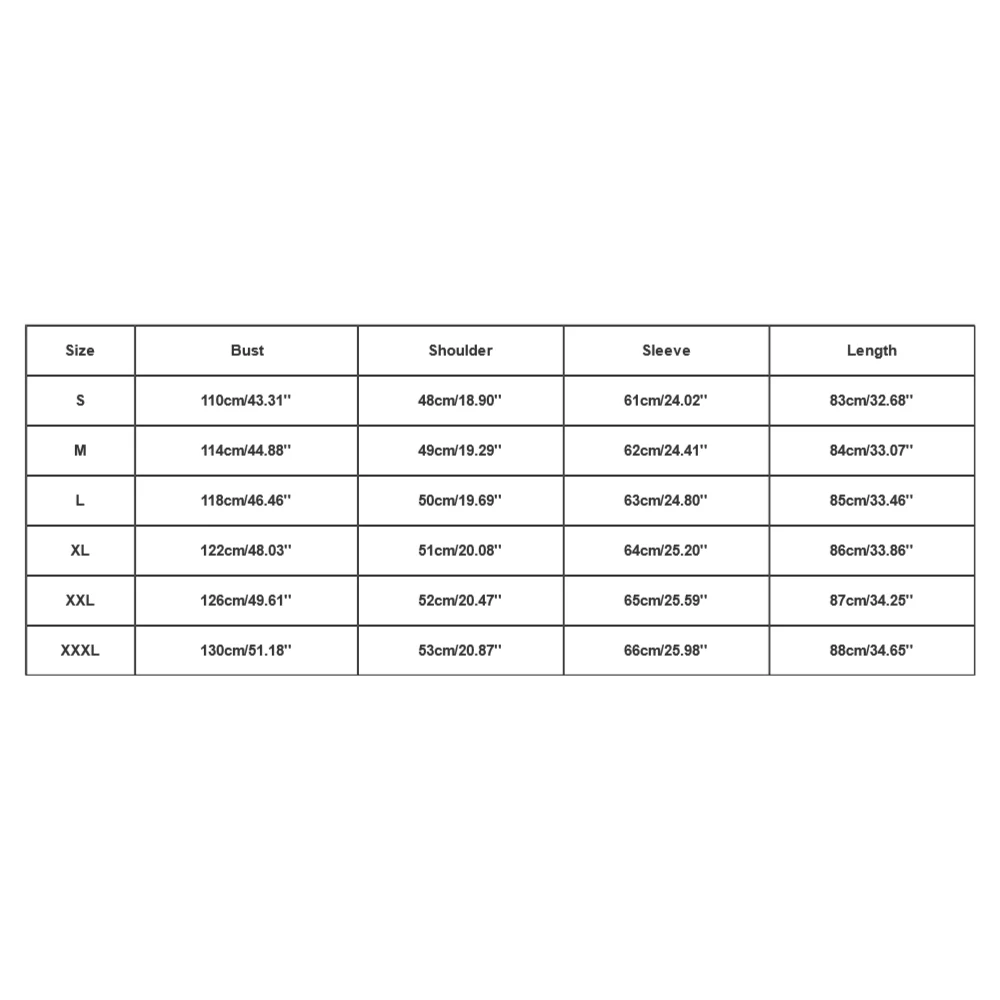
Styling Tips: Enhancing Your Look Through Strategic Length Choice
The right coat length can serve as a powerful styling tool when coordinated with other elements of your wardrobe:
Create Cohesive Proportions
– Pair longer coats with straight or slim trousers for balanced proportions
– Match shorter coats with slim-fitting bottoms to maintain a streamlined silhouette
– Consider the visual weight of your footwear—heavier boots often pair better with longer coats
Coordinate with Pants Styles
– Wider-leg trousers generally work better with knee-length or longer coats
– Slim or tapered pants pair well with both short and long coat styles
– Avoid having your coat end at exactly the same point as a major pant feature (like the bottom of pant cuffs)
Accessory Integration
– Longer scarves complement longer coats
– Consider belt styles that work with your coat length—wider belts often pair better with shorter coats
– Bags and briefcases should be proportional to coat length
Footwear Pairings
– Taller boots balance longer coat lengths
– Dress shoes and loafers work well with classic knee-length styles
– Casual sneakers often pair better with hip to mid-thigh length coats
Layering Strategies
– Shorter coats work better when layering over bulkier sweaters or hoodies
– Longer, slimmer coats pair well with lighter, more streamlined under-layers
– Consider visible layer lengths—having each layer slightly shorter than the one above creates visual interest
Understanding the difference between short vs. long coats helps you make strategic styling decisions that enhance your overall appearance.
Can Coat Length Be Altered? What to Know About Tailoring
While some aspects of coat fit can be easily altered, length adjustments require special consideration:
Shortening Possibilities
Most coats can be shortened by 2-4 inches without significantly altering their design integrity. Shortening is the more common and straightforward length alteration.
Length Extension Limitations
Lengthening is much more difficult and often impossible without visible seams or added fabric panels. Some coats may have extra fabric in the hem that allows for minor lengthening of up to 1-2 inches.
Design Complications
Certain design elements make length alterations challenging:
– Vents (especially center vents) must be reconstructed when shortening
– Decorative hem details may be lost during alteration
– Pockets positioned near the hem may need to be relocated
Cost Considerations
Length alterations typically cost more than simple sleeve adjustments:
– Basic shortening: $50-$100
– Complex shortening (with vents/details): $100-$200+
– Lengthening (when possible): $75-$250+
When to Alter vs. When to Find a Better Fit
Consider alteration when:
– The coat fits perfectly everywhere except length
– It’s a high-quality investment piece worth the tailoring expense
– The required adjustment is minor (2-3 inches or less)
Consider finding a different coat when:
– Multiple alterations would be needed
– The cost of alterations approaches 50% of the coat’s value
– The required length change would significantly affect the coat’s design
Investment Considerations: Longevity and Versatility of Different Lengths
When investing in quality outerwear, consider how length affects long-term value:
Most Versatile Lengths
Mid-thigh to knee-length coats typically offer the greatest versatility across situations. These moderate lengths work in most professional and casual settings while providing adequate weather protection.
Classic vs. Trend-Driven Lengths
Extremely short or extremely long coats tend to be more fashion-forward and may cycle in and out of style. Mid-range lengths have remained consistently acceptable for decades.
Assessing Timelessness
When evaluating a coat’s potential longevity:
– Consider whether the length is tied to a specific trend
– Look at historical photos of similar coat styles
– Ask whether the length serves a practical purpose beyond aesthetics
Building a Coat Collection
A well-rounded wardrobe might include:
– A classic knee-length overcoat for business and formal occasions
– A hip to mid-thigh length casual option for everyday wear
– A technical option in an appropriate length for your climate’s worst conditions
Cost-Per-Wear Analysis
More versatile lengths often yield better value over time:
– A knee-length wool overcoat might be worn for business, formal events, and casual settings
– Very short or very long styles may have more limited use cases
Our wool overcoat collection features investment-quality pieces in classic proportions designed to provide enduring value and style.
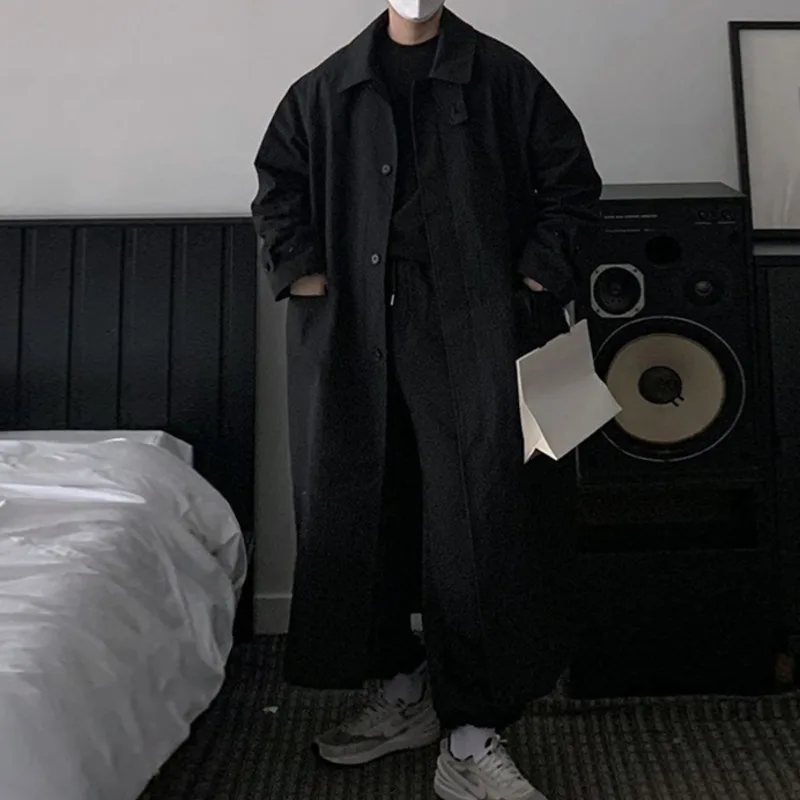
Is There a Most Versatile Coat Length for Men?
While individual needs vary, two lengths compete for the title of “most versatile”:
The Case for Knee-Length
Knee-length coats offer exceptional versatility because they:
– Provide substantial weather protection
– Cover business attire completely
– Work across formal, business, and smart-casual settings
– Create a classic silhouette that rarely looks out of place
– Balance warmth with mobility
The Case for Mid-Thigh
Mid-thigh length coats offer modern versatility because they:
– Work well in both casual and business-casual environments
– Provide good mobility for active lifestyles
– Suit a wide range of body types
– Transition easily between different transportation modes
– Generally look contemporary without being trendy
Your personal “most versatile” length depends on your lifestyle. If you regularly wear suits or formal attire, knee-length provides better coverage. If your life is more casual or active, mid-thigh may serve you better.
Mens Heavy Winter Coat, Mens Insulated Coat, Mens Parka Coat
Price range: $175.52 through $237.36 Select options This product has multiple variants. The options may be chosen on the product pageMens Big and Tall Winter Coats, Mens Down Coat, Mens Hooded Winter Coat, Mens Puffer Coat
Price range: $126.44 through $217.01 Select options This product has multiple variants. The options may be chosen on the product pageMens Big and Tall Winter Coats, Mens Hooded Winter Coat
Price range: $80.32 through $106.68 Select options This product has multiple variants. The options may be chosen on the product pageMens Double Breasted Pea Coat, Mens Wool Blend Coat, Mens Wool Pea Coat
Price range: $136.84 through $157.36 Select options This product has multiple variants. The options may be chosen on the product pageMens Cashmere Overcoat, Mens Hooded Winter Coat, Mens Wool Blend Coat
Price range: $128.72 through $139.68 Select options This product has multiple variants. The options may be chosen on the product pageMens Hooded Winter Coat, Mens Insulated Coat, Mens Puffer Coat, Mens Quilted Coat
Price range: $139.88 through $177.72 Select options This product has multiple variants. The options may be chosen on the product page
Can Shorter Men Wear Longer Coats?
Absolutely! The myth that shorter men must avoid longer coats overlooks the importance of proportion and styling. Shorter men can successfully wear longer coats by following these guidelines:
- Choose coats that are proportional to your body—ending at the knee rather than mid-calf
- Ensure a trim fit through the body to avoid adding visual bulk
- Select styles with vertical elements like a single-breasted closure or narrow lapels
- Pay special attention to shoulder fit—oversized shoulders will undermine the overall look
- Consider having a longer coat custom-tailored to your proportions
The key is finding the right balance between length and your overall height. A well-fitted knee-length coat can actually elongate your silhouette more effectively than an ill-fitting shorter coat.
What’s the Ideal Coat Length for Covering a Suit Jacket?
When wearing a coat over formal business attire, proper coverage is essential for both appearance and protection:
- The overcoat should extend 2-3 inches (5-7.5 cm) beyond the bottom of your suit jacket or blazer
- For standard suit jackets, this typically translates to a coat length of 34-38 inches (86-97 cm)
- The coat should completely cover your suit jacket from all angles
- When seated, the coat should still provide adequate coverage of your suit
Traditional business overcoats typically end just below the knee to ensure complete coverage even when walking or sitting. Modern interpretations may be slightly shorter (ending just above the knee) while still covering the suit jacket.
Our wool blend coat collection includes options with proportions specifically designed to properly cover business attire while maintaining a refined appearance.
How Have Fashionable Coat Lengths Changed Over Time?
Coat length preferences have evolved significantly throughout fashion history:
In the early 20th century, formal overcoats were quite long, often reaching mid-calf or even ankle length. This provided maximum warmth and signaled formality and status.
By the mid-20th century, knee-length became standard for business overcoats, balancing tradition with practicality as urban lifestyles evolved.
The 1960s and 1970s saw experimentation with shorter lengths, reflecting the era’s rejection of formality. Hip-length and car coats gained popularity during this period.
The 1980s brought a return to longer, more dramatic silhouettes, with full-length coats making a comeback in formal settings.
Contemporary trends have embraced variety, with everything from cropped styles to full-length options appearing simultaneously in fashion. However, mid-thigh to knee-length remains the versatile middle ground that consistently stays in style.
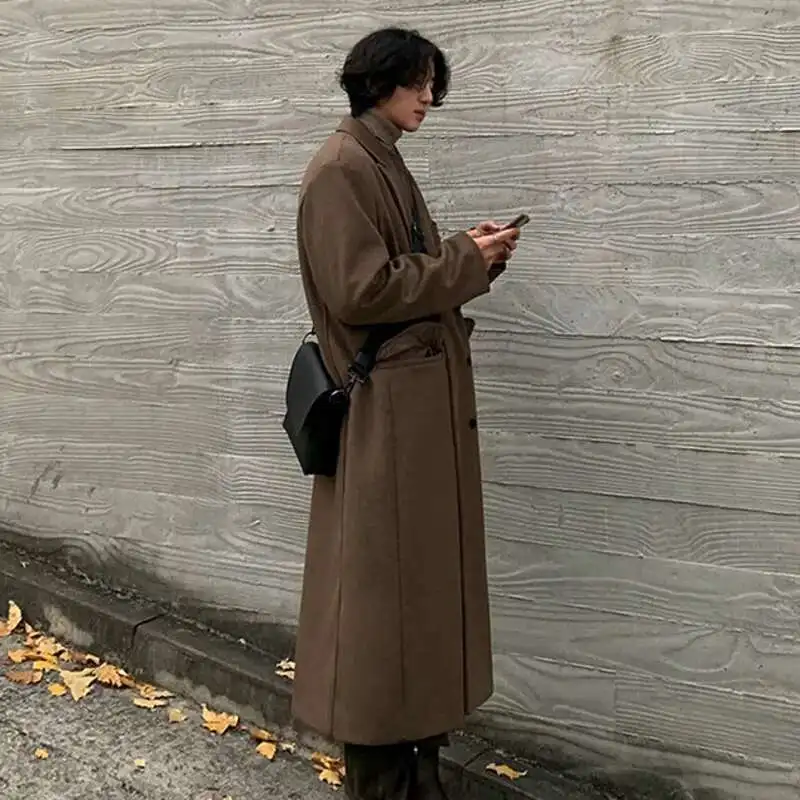
Our herringbone coat collection features this classic pattern in traditional lengths that have remained stylish across decades of changing fashion trends.
What Coat Lengths Work Best for Active Lifestyles?
Men with active lifestyles need coats that provide protection without restricting movement:
For Urban Commuters
Mid-thigh length coats typically offer the best balance of coverage and mobility for city navigation. Look for styles with:
– Side vents or a center vent for walking stride
– Slightly relaxed shoulder fit for arm movement
– Practical pocket placement for everyday essentials
For Outdoor Activities
Hip to mid-thigh technical coats provide protection while allowing greater range of motion. Consider features like:
– Articulated sleeves that move with your arms
– Adjustable hems that can be tightened or loosened as needed
– Strategic venting that allows heat release during activity
For Drivers
Car coats ending at mid-thigh were specifically designed for comfortable driving. They provide:
– Adequate coverage when seated
– Freedom from bunching or riding up
– Comfortable arm positioning for steering
Modern technical fabrics have expanded the possibilities for active coats, allowing longer lengths to offer better mobility than traditional materials would permit.
Frequently Asked Questions About Coat Length
How do you know if a coat is too long?
A coat is too long if it bunches when you sit down, restricts your walking stride, or makes your legs look disproportionately short compared to your torso. The hem should never touch or drag on the ground.
Can coat length affect perceived weight or build?
Yes, coat length significantly impacts how your body appears. Longer coats can add perceived bulk to thin frames but may also make larger builds appear more substantial. Mid-length coats that end at a narrower part of the leg often create the most balanced silhouette.
Does sleeve length need to coordinate with coat length?
Absolutely. Sleeve length and coat length should be proportional—longer coats generally pair with slightly longer sleeves. The sleeve should end at or just below your wrist bone, allowing about ¼ to ½ inch of shirt cuff to show.
How should coat length relate to height?
While there are no absolute rules, coat length should generally be proportional to height. Taller men can wear longer coats without being overwhelmed, while shorter men might opt for lengths that end at narrower parts of the leg (just above the knee rather than mid-calf) for better proportion.
Are there any universal rules for coat length regardless of style?
The most universal guideline is that the coat should cover what’s underneath it—whether that’s a suit jacket, sweater, or other layered items. Beyond that, proper proportion to your body is the most important consideration.
For more detailed information about longer coat options and their benefits, our guide to long winter overcoats provides comprehensive advice about both style and function considerations.
Finding the perfect coat length involves balancing personal style with practical needs and body proportions. By understanding these fundamental principles, you’ll be equipped to select outerwear that not only keeps you warm but enhances your overall appearance and provides lasting value.

